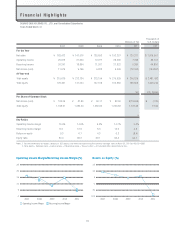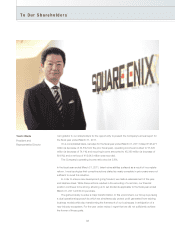Square Enix 2011 Annual Report Download - page 7
Download and view the complete annual report
Please find page 7 of the 2011 Square Enix annual report below. You can navigate through the pages in the report by either clicking on the pages listed below, or by using the keyword search tool below to find specific information within the annual report.
1975 1985 1995 2005 2015E
Amusement/ArcadeAmusement/Arcade
Console Game Hardware
Console Game Software
Mobile Games
Mobile Games
PC, etc.
(Online Games)
Browser Games
Cloud Games
Market Size
Various sources compiled by the Company
The Game Industry—Growing on Lower Investment Requirement to Play
Figure 4
Historical Development of the Game Industry
For a deeper understanding of our basic strategy, I would now
like to describe our outlook for the gaming industry while reviewing
historical developments to date. Our Group created, and is now
implementing, a strategy based on a clear understanding of
the game industry’s history.
Within the growth of the games industry, there is a clear trend
appearing.
Games are an incredibly complex application, and making
them work requires an environment of incredibly high capabilities.
In order for a customer to play a game, such application software
requires an investment in the operating environment, namely
hardware. As the required investment in the environment is
reduced, the entry barrier for consumers is lowered and the
game industry grows (Figure 4).
In the early stages of the video game industry, making a
game run was difficult and each individual game required its
own unique hardware. To that end, arcade owners purchased
machines, and the business model saw these owners spread
the investment cost to their customers in the form of coin
operations.
Next, Nintendo developed its Nintendo Entertainment
System (NES), and the investment cost for the average
consumer to own a game machine was greatly reduced. This
was the birth of the home video game console industry.
From there, the console game market grew quickly as the
capabilities of each game console advanced and third-party
developers increased the overall supply of software.
In 2000, when the PlayStation 2 System was released, the
concept of the game console as a games-only device
disappeared. At one price, you gained both a game console
and a DVD player, which had the effect of dramatically reducing
the consumer’s investment in the environment specifically to
play games.
In the years following, people gained the ability to play
games on mobile phones in Japan. With this, we entered the
age of general purpose devices capable of playing games.
While PCs had been capable of playing games for some time,
PCs with such extremely high specifications required by games
began to serve as de facto game consoles. Now, however, we
find that even average PCs are capable of allowing people to
enjoy games as well.
Since the 2007 debut of the iPhone, smartphones and
tablet PCs have spread rapidly, fully establishing the lifestyle of
playing games on general purpose devices. Furthermore,
around 2006, all game devices became connected to the
Internet, which can be viewed as a critical aspect of the
industry’s subsequent expansion.
05




















